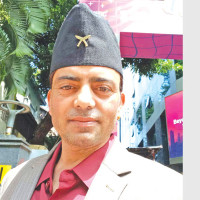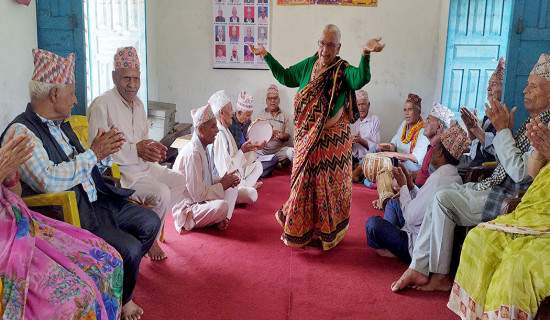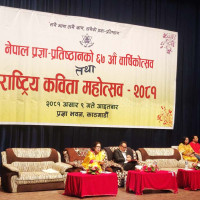- Wednesday, 26 June 2024
From Fiction To An Educational Odyssey
In grade three, my village teacher asked me, "What is Darbhanga famous for?"
I could not reply; instead, my head was down on the floor. Another incident in the city was in fifth grade with the school inspector. He pointed at me with a surprise question as soon as he entered the class.
"Which district do you live in?"
"Purnea!" I said.
Then the inspector walked away without a response, and the last-hour school bell roared. Two days later, my junior said,
"No, you’re wrong! Purnea is in Bihar; we live in the district of Morang."
In truth, our GK was richer about Hindustan’s history and geography than our own. Biratnagar was an industrial city since Rana rule, but it lacked education awareness. Only a couple of formal schools existed at the time. Teachers and textbooks came from Hindustan.
Education, not for all
Schooling then was a battle for the parents. The city had just two-three schools, reaching where it took a long march. Landlords sent their children to the cities of Hindustan, like Darbhanga, Benaras, and Calcutta, as education was a big credit. Small-income parents could manage it only locally.
Education thus implied the personal initiative of parents, as government funding was as rare as a blue moon. Parents, as such, arranged homeschooling for their children by hiring a teacher that not all could afford. In this, a teacher visited the learner with explicit tailor-made lessons and also taught samskar (tradition).
Teachers and school
In the village school, we were just kids, and when nature called, we didn't think twice about it. We emptied our bowels behind a bush beside the river, just like that—no fuss, no frills, just the open sky above and the earth beneath our feet. An education building stood upon a few large-hearted donors. First procure a wide space for classrooms, admins, playgrounds, etc., and inch by inch of such space came against money. Then came the building of the structure with bricks and construction materials, along with labor. Each item asked for tight Hindustani money in local circulation.
The last component was teachers. As already said, they were from the neighbouring part. Hiring such hands was a challenge too, as it involved provisions for housing and salary. Since resources were weak, promises to pay were sure to fail. They had to wait months for wages unless they behaved like a local teacher in terms of delay and difficulty. The formal schools of early Morang had no good buildings. A Rana Prime Minister, Juddha Shamsher, had donated a sum of five thousand rupees of British raj for the city school. The school proudly remembered him as Juddha High School, Biratnagar. Since it could not meet the need for girls, twenty years later, the city received a girls’ high school too. Gradually, many more schools emerged.
Painful start of college
The same story repeats about college. The city then required higher education as an industry of social welfare that asked for factors of production like land, labour, capital, organisation, and enterprise. In true terms, a college needed space, buildings, money, and a committed group. Thus, in the mid-50s, a few city elites were involved in planning and developing the college. Money was its foremost need for a land plot and a building. It asked for land in thousands of square metres, a unit of money in hundreds of thousands, a unit of bricks in hundreds of thousands along with related materials, and a unit of labour sweating in thousands. So the selected elite put the planning to the local governor, Badahakim, for support. They decided on a short-term measure—a levy of (British raj) one-rupee-one-bigha (bigha is land measurement) aside from land revenue.
Under this, small and big landowners in Morang, then Sunsari too, paid it. The fund, which had been raised for three years, purchased 10 bighas. Then a huge new building stood, serving the purposes of classrooms, libraries, and administration. That was a terrible bulwark in Morang for education. But the irony was teachers again. Local fellows were either not qualified or had little interest in teaching, and the Hindustan nearby border parts solved this too. But such teaching hands came with a challenge. They required housing, a salary, safety, and to be paid on time for their daily meals, at least! In fact, if salary was one item, the college would require essential costs for administrators, the library, facilitating sports, and so on. Tuition fees received from students were a drop in the ocean.
Anyway, the college has now stood up. It had engraved the memory of several unrecorded and unsung heroes. These were the big and small landowners, in tens of thousands, who followed the request of one-rupee-one-bigha. The college owes its start to all of them. Tribhuvan University emerged only after this college.
Incidentally, Morang College added another name to the title ten years later. The king’s first name came first to become Mahendra Morang College. On the contrary, Juddha High School had changed its name to Adarsha Vidyalaya after the Ranas. Truly said, Morang College was a blessed name upon the donation and contribution of indigenous dwellers of Morang, then Susari too, before it was a new district. Otherwise, at the start, it ran classes and admins in the Adarsha Vidyalaya building in the evening.
No small words
In brief, schooling and college were wonderful journeys along our path. To school, we moved without shoes and celebrated the hours as the rains dismissed them. All of them together were for divine samskar—discipline and good conduct, knowledge, unity, harmony, peace loving, etc. Parents were grateful too for how the school, college, and teachers had qualified the children.
Stages of education revive a romantic memory today. As such, our schooling started in a makeshift shed. It was then forwarded to formal schooling. Eventually, it reached the level of college, despite the ever-growing economic distress for parents and institutions alike. Meanwhile, teachers made s uperhuman discoveries. The lessons they taught are a tribute now. The gratitude is for alma mater buildings too, like the shrine of goddess Saraswati. In fact, their products are a source of pride. Such are the true emotions and ethics that instil in us the need to preserve the buildings, each unit of bricks, and to duly honour the teachers who drove us from the dark ages to the light of education. Those days were literally painful for society. The circumstances of education were too painful to be a mere story now.
(Baral is a retired lecturer of English.)
















